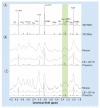Preclinical (1)H-MRS neurochemical profiling in neurological and psychiatric disorders
- PMID: 22877223
- PMCID: PMC3922617
- DOI: 10.4155/bio.12.129
Preclinical (1)H-MRS neurochemical profiling in neurological and psychiatric disorders
Abstract
The ongoing development of animal models of neurological and psychiatric disorders in combination with the development of advanced nuclear magnetic resonance (NMR) techniques and instrumentation has led to increased use of in vivo proton NMR spectroscopy ((1)H-MRS) for neurochemical analyses. (1)H-MRS is one of only a few analytical methods that can assay in vivo and longitudinal neurochemical changes associated with neurological and psychiatric diseases, with the added advantage of being a technique that can be utilized in both preclinical and clinical studies. In this review, recent progress in the use of (1)H-MRS to investigate animal models of neurological and psychiatric disorders is summarized with examples from the literature and our own work.
Figures



Similar articles
-
Quantitative in vivo neurochemical profiling in humans: where are we now?Int J Epidemiol. 2016 Oct;45(5):1339-1350. doi: 10.1093/ije/dyw235. Epub 2016 Oct 29. Int J Epidemiol. 2016. PMID: 27794521 Free PMC article. Review.
-
Applications of magnetic resonance spectroscopy to the investigation of neuropsychiatric disorders.Neuropsychopharmacology. 1992 Jun;6(4):249-66. Neuropsychopharmacology. 1992. PMID: 1632893 Review.
-
Magnetic resonance spectroscopy studies of GABA in neuropsychiatric disorders.J Clin Psychiatry. 2003;64 Suppl 3:7-14. J Clin Psychiatry. 2003. PMID: 12662128 Review.
-
Metabolic characterization of neurological diseases by proton localized NMR spectroscopy of the human brain.C R Acad Sci III. 1992;315(7):287-93. C R Acad Sci III. 1992. PMID: 1336428
-
Magnetic resonance spectroscopy: current and future applications in psychiatric research.Biol Psychiatry. 2002 Feb 1;51(3):195-207. doi: 10.1016/s0006-3223(01)01313-0. Biol Psychiatry. 2002. PMID: 11839362 Review.
Cited by
-
Moderate relationships between NAA and cognitive ability in healthy adults: implications for cognitive spectroscopy.Front Hum Neurosci. 2014 Feb 14;8:39. doi: 10.3389/fnhum.2014.00039. eCollection 2014. Front Hum Neurosci. 2014. PMID: 24592224 Free PMC article.
-
A Review of Translational Magnetic Resonance Imaging in Human and Rodent Experimental Models of Small Vessel Disease.Transl Stroke Res. 2021 Feb;12(1):15-30. doi: 10.1007/s12975-020-00843-8. Epub 2020 Sep 16. Transl Stroke Res. 2021. PMID: 32936435 Free PMC article.
-
High-field proton magnetic resonance spectroscopy reveals metabolic effects of normal brain aging.Neurobiol Aging. 2014 Jul;35(7):1686-94. doi: 10.1016/j.neurobiolaging.2014.01.018. Epub 2014 Jan 23. Neurobiol Aging. 2014. PMID: 24559659 Free PMC article.
-
Neuropharmacological and neurobiological relevance of in vivo ¹H-MRS of GABA and glutamate for preclinical drug discovery in mental disorders.Neuropsychopharmacology. 2014 Sep;39(10):2331-9. doi: 10.1038/npp.2014.79. Epub 2014 Apr 3. Neuropsychopharmacology. 2014. PMID: 24694923 Free PMC article.
-
Alzheimer's disease biomarkers in animal models: closing the translational gap.Am J Neurodegener Dis. 2013 Jun 21;2(2):108-20. Print 2013. Am J Neurodegener Dis. 2013. PMID: 23844335 Free PMC article.
References
-
-
Licata SC, Renshaw PF. Neurochemistry of drug action: insights from proton magnetic resonance spectroscopic imaging and their relevance to addiction. Ann. NY Acad. Sci. 2010;1187:148–171. ■■ Excellent review on the use of magnetic resonance spectroscopy (MRS) imaging in addiction.
-
-
-
Choi JK, Dedeoglu A, Jenkins BG. Application of MRS to mouse models of neurodegenerative illness. NMR Biomed. 2007;20(3):216–237. ■■ Excellent review on the use of MRS imaging in neurological disorders.
-
Publication types
MeSH terms
Substances
Grants and funding
LinkOut - more resources
Full Text Sources
Medical
